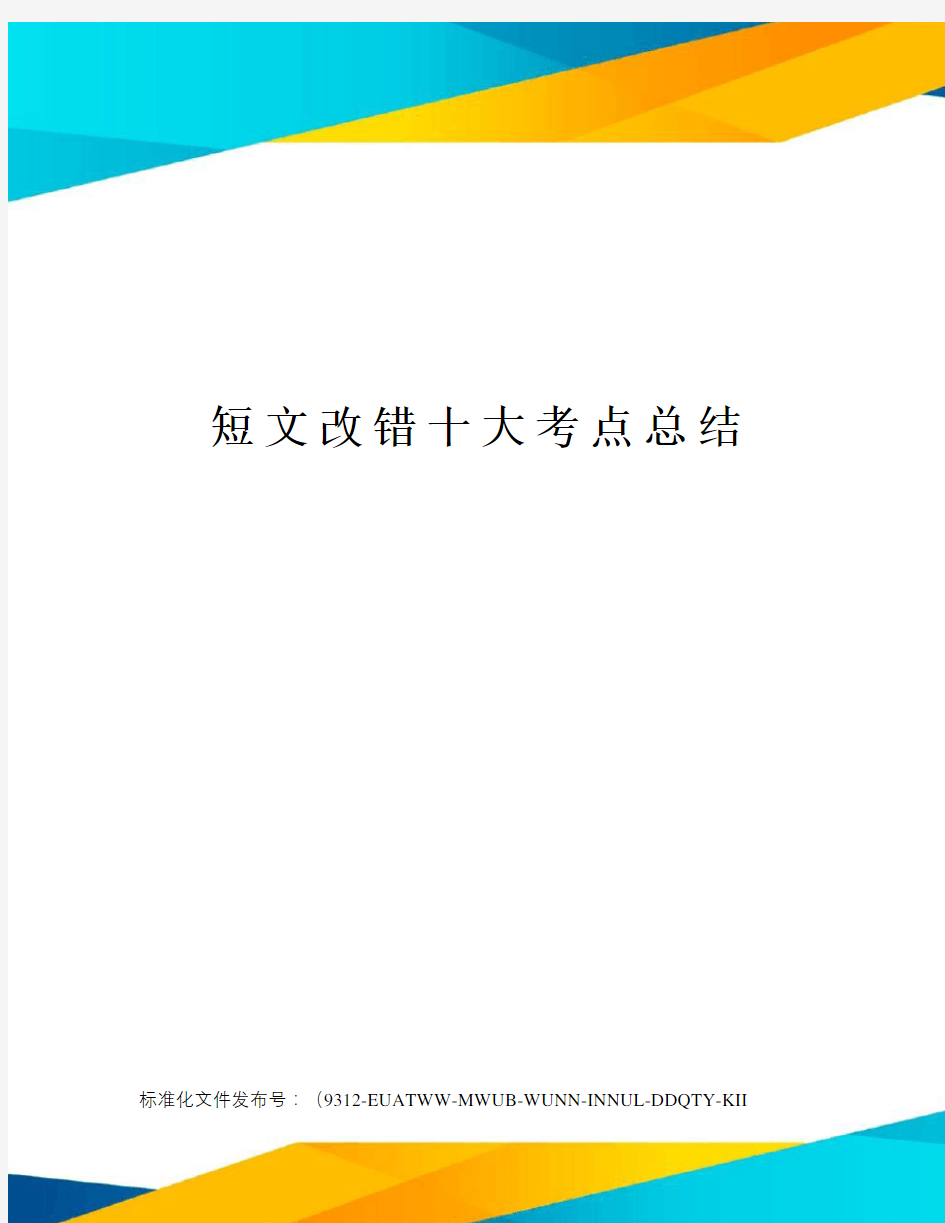

短文改错十大考点总结标准化文件发布号:(9312-EUATWW-MWUB-WUNN-INNUL-DDQTY-KII
考点破解一:名词的数与格的误用
真题再练
下列各小题中有且仅有一处错误(多1个单词、少1个单词、错1个单词),请指出并改正过来,然后说明理由。
1.(2015新课标卷I) The airs we breathe in is getting dirtier and dirtier.
2.(2014新课标卷I) Since then—for all these year—we have been allowing tomatoes to self-seed where they please.
3.(2013新课标卷I) He was tall, with broad shoulder and a beard that turned from black to gray over the years.
4.(2012新课标卷) From the time I was about four until I was about six, I destroyed each of my toy.
5.(2011新课标卷) It felt very strange to travel without any luggages.
6.(2011新课标卷) When I finally arrived at my friend he lent me lots of clothes.
7.(2015新课标卷II) One day, little Tony went to a shopping center with his was very crowded. …he turned around and found that his parents were missing.
8.(2014新课标卷II) For example, we can do reading for one and a half hour and play sports for one hour every day.
9.(2013新课标卷II) When tea got popular in Britain, there was a crying need for good cup with handles to suit British habits.
思路点拨
解答这类题主要有6条依据:
1.依据可数名词与不可数名词的用法特点。
可数名词大于一时要用复数,不可数名词一般没有复数形式。如air, milk, water 等物质名词与music, advice, fun等抽象名词是不可数名词,一般是没有复数形式的。还有luggage, furniture, equipment等都是容易出错的不可数名词。
2.依据名词前的修饰语。
如名词前有these, those, ten等修饰时,应当用复数。如[真题再练]2,these year就错了,要用these years才正确。
3.依据主谓一致原则。
如果谓语动词是复数,主语也应是复数;如果谓语动词是单数,主语也应是单数。如[真题再练]1,谓语是is getting,而主语是airs,可知这里一定有问题。
4.依据上下文信息。
如[真题再练]7,Tony went toa shopping center with his parent,汤姆是同他的父亲或母亲,还是同他父母一起去商场下文his parents were missing告诉我们,是同父母一起去的,故parent应用复数。
5.依据生活常识。
如[真题再练]3,一个人的肩膀是有左有右的,应当用复数。如果没有这个常识就无法正确指出with broad shoulder这一错误。
6.依据逻辑意义。
如[真题再练]6,“当我最终到达朋友时”,“到达朋友”怎么讲得通呢这里一定有问题,应当是“到达朋友的家”才通顺。
考点归纳
名词是短文改错的必考点,5年8套题中无一例外。主要考查名词的“数”与“格”,具体有3点:
1.不可数名词没有复数,文中却用了复数。
如[真题再练]第1题和第5题。要牢记常见的不可数名词,如:fun, advice,information, work(工作), homework, housework, progress, luggage, furniture, equipment,money等。
2.可数名词该用复数时,文中却用了单数。
如[真题再练]第2、3、4、7、8、9题。显然,这是考查的重点。要注意可数名词前有these, those, several, few, many, a large number of, each of, one of, 或大于1的数词修饰时,以及虽无这些词但根据语境其意义大于1时,一定要用复数形式。
3.表示“某人的”本应用名词的所有格,文中却没用。
如[真题再练]第6题。注意,以下情况中,名词所有格后的名词可省略:a butcher’s(shop)肉铺,a tailor’s(shop)裁缝店,a barber’s(shop)理发店,a doctor’s(office)诊所,my sister’s(home)我姐姐家,其中shop,office, home等
表示处所的词都可以省略,直接用名词所有格表示。
考点破解二:代词的误用与漏用
真题再练
下列各小题中有且仅有一处错误(多1个单词、少1个单词、错1个单词),请
指出并改正过来,然后说明理由。
1.(2015新课标卷I) We must find ways to protect your environment. If we fail to do so, we’ll live to regret it.
2.(2013新课标卷I) He had a deep voice, which set himself apart from others…
3.(2012新课标卷) I was happy when the toys worked, but when things went wrong,
I got angry and broke it.
4.(2012新课标卷) For a while, parents bought me new toys.
5.(2015新课标卷II) Five minutes later, Tony saw parents.
思路点拨
解答这类题需注意两点:
1. 弄清指代对象。
凡是核查代词是否有错,关键是核查该代词的指代对象,即到底是指代谁或什么,弄清指代的对象是人还是物,是男还是女,是单数还是复数。
2. 留意三无名词。
即要特别留意前面无冠词、无物主代词、无不定代词的名词。遇到三无名词,要自问:是泛指吗如果不是泛指,具体又是谁的呢如[真题再练]第4题,“父母给我买了新玩具”,是泛指天下所有的父母不是!是谁的父母给我买玩具我的父母!故parents前应加上my。
考点归纳
代词是短文改错的常考点,5年8套题中考了5次。主要从5个方面考查代
词。
1. 前后人称不一致。如[真题再练]1,your与前后的we不一致。
2. 前后单复数不一致。如[真题再练]3,it与指代对象the toys在单复数上不一致。
3. 前后的性别不一致。如前后谈的是一个女人,却冒出he或his来,反之亦然。
4. 物主代词的漏用。如[真题再练]4、5题。
5. this, that, it的区别;anything与everything的区别。
考点破解三:冠词的混用、多用与少用
真题再练
下列各小题中有且仅有一处错误(多1个单词、少1个单词、错1个单词),请指出并改正过来,然后说明理由。
1.(2015新课标卷I) Now I am living in a city, but I miss my home in countryside.
2.(2014新课标卷I) As result, the plants are growing everywhere.
3.(2013新课标卷I) In a fact, he even scared my classmates away when they came over to play or do homework with me.
4.(2011新课标卷) I was going to visit a friend there, and after that, I would go to Xiamen for long holiday.
5.(2015新课标卷II) He liked it so much that he quickly walked into the shop… A woman saw him crying and told him to wait out side a shop.
6.(2014新课标卷II) My dream school looks like a big garden. There are all kinds of the flowers and trees around the classroom buildings.
7.(2013新课标卷II) This custom soon became another meal of day.
思路点拨
1.留意三无名词。
遇到无冠词、无形容词性物主代词、无不定代词修饰的单数可数名词要注意,若根据语境不是将其变为复数,就一定是在前面加冠词。如[真题再练]4、7。
2.留意固定词组。
固定词组常积累,就成火眼金睛,一看便知错。如[真题再练]1、2、3。3.考究是否用错。
要根据冠词的基本用法,如定冠词表示特指,一般来说不是特指不用定冠词;不定冠词表泛指,常可译作“一个/本/支”等,意义不通,可能有错。如[真题再练]6。冠词的基本用法可参见语法填空部分。
考点归纳
冠词在5年8套题中考了7次,可算作必考点。主要从以下3个方面考查冠词:
1. 混用。
即a, an与the的混用。如[真题再练]5。
2. 多用。
如[真题再练]第3、6题。考查的内容是“零冠词”,即不用冠词的情况:
(1)专有名词前,如Tom, China等。
(2)学科名词前,如I like physics。
(3)球类运动名词前,如play football等。
(4)三餐名词前,如have breakfast等。
(5)唯一职位名词前,如chairman, president等。
(6)名词前已有物主代词或不定代词时,如my teacher, some students等。
(7)抽象名词和物质名词等不可数名词表示泛指时,如I’m fond of music.
(8)可数名词的复数形式表示泛指或指一类事物时,如[真题再练]6。
(9)不用冠词的固定词组,如[真题再练]3。
3. 少用。
这是考查的重点,8套题中考了4次。如[真题再练]第1、2、4、7题。要特别留意含有冠词的固定词组。如[真题再练]第1、2题。
考点破解四:介词误用、多用与少用
真题再练
下列各小题中有且仅有一处错误(多1个单词、少1个单词、错1个单词),请
指出并改正过来,然后说明理由。
1.(2015新课标卷I) Unfortunately, on the development of industrialization, the environment has been polluted.
2.(2014新课标卷I) Nearly five years ago, and with the help by our father, my sister and I planted some cherry tomatoes in our back garden.
3.(2013新课标卷I) He was tall, with broad shoulders and a beard that turned from black towards gray over the years.
4.(2012新课标卷) When I tore apart my fifth birthday toy train, my father said,“That’s it. No more toys to you.”
5.(2011新课标卷) Luckily, I had all my money on my pocket, but the only clothes I had were those I had on.
6.(2011新课标卷) When I finally arrived at my friend’s he lent to me lots of clothes.
7.(2015新课标卷II) Tony saw a toy on a shop window. He liked it very much.
8.(2014新课标卷II) Therefore, we have more time with after-school activities.
9.(2014新课标卷II) We can lie on the grass for a rest, or sit by the lake listening music.
10.(2013新课标卷II) The book I’m reading of talks about afternoon tea in Britain.
11.(2013新课标卷II) Interestingly, it had a connection by the British porcelain(瓷器) industry.
思路点拨
因介词是短文改错的必考点,且可能不止考1题,所以凡遇到介词,要高度警惕。
1. 意义通不通
一遇到介词,就从介词的基本意义出发,看句意通不通或是否符合常识。如
[真题再练]5,“幸运的是,我所有的钱都在我口袋的表面上”,显然不合常识。
2. 搭配对不对
一遇到介词,就要瞻前顾后,看它是否符合搭配习惯。如[真题再练]3,遇到toward,是否正确看看前面,有turn,可想到turn…into,或由from想到from…to。
3. 念念顺不顺
如果平时有大声朗读的习惯,并留意了固定搭配,考场中只需默默念一念,就
可感觉出有没有错误。如你听熟或读顺了listen to me, read a book,当你念到
listen music, read of a book时就觉得不顺了,肯定是错的。这种方法特别适合辨识不及物动词后漏掉介词或及物动词后又增加介词的错误。
考点归纳
介词是改错题中必考考点,且5年8套题中考了11道,是重点考查内容,我们必须高度重视。从高考真题来看,考查内容有以下特征:
1. 常见的介词。
如in, of, for, with, to, into等。
2. 基本的用法。
如in表示“在……里”,on表示“在……的表面上”,for引导接受某物的对象,等等。但也有个别题相对较难,如time for after-school activities(做课外活动的时间)。
3. 固定的词组。
在这11道题中,有6道考查固定词组,超过一半。因此,含介词的固定词组我们就不得不重视了。要收集,要熟读,读得朗朗上口。
考点破解五:连词误用、多用与少用
真题再练
下列各小题中有且仅有一处错误(多1个单词、少1个单词、错1个单词),请
指出并改正过来,然后说明理由。
1.(2015新课标卷I) In the countryside, the air is clean or the mountains are green.
2.(2014新课标卷I) Although we allow tomato plants to grow in the same place year after year, but we have never had any disease or insect attack problems.
3.(2013新课标卷I) He had a deep voice, which set him apart from others in our small town, he was strong and powerful.
4.(2013新课标卷I) In fact, he even scared my classmates away during they came over to play or do homework with me.
5.(2012新课标卷) But before long, they began to see which was happening.
6.(2011新课标卷) I bought my ticket but turned around to pick up my bag from the floor, and then I realized that someone had stolen it.
7.(2015新课标卷II) After looking at the toy for some time, he turned around and found where his parents were missing.
8.(2013新课标卷II) Having tea in the late afternoon provides a bridge between lunch and dinner, that might not be served until 8 o’clock at night.
思路点拨
1. 句间无连词,增加连词。
凡是两个句子之间没有句号、分号,又没有连词时,一定是漏掉连词了,要根据两句之间的意义关系或逻辑关系,增加一个恰当的连词。
2. 句间多连词,删除连词。
虽然同一句子中的两个主谓关系之间一定有连词,但又不能多,只需一个,多了就错了。特别是受汉语的影响,易将although /though…but(虽然……但是……), because/since /as…so (因为……所以……)连用,遇到此种情况,一般删除后面的but, so, 以免影响一个句子的第一个单词首字母大写的原则。
3. 遇到连词要考究是否用错。
如or (表选择), and (表顺承), but (表转折)之间是否用错,要根据句意的理解、前后的逻辑关系去判断。